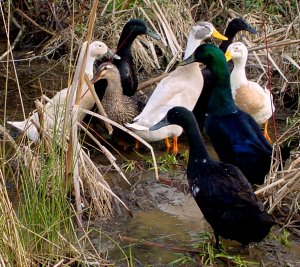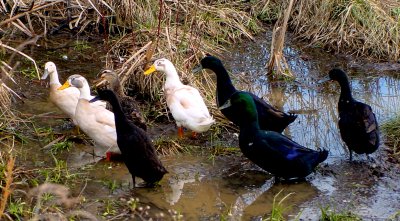
As I stood composing this shot, a woman passing by with grocery bags stopped beside me. Looking at the bicycle, she tilted her head to the side and smiled. "That bike!" she said, "It looks like... happiness." It was a funny outburst, no doubt inspired more by the sunny day and the quaint tree-lined street, than by the bicycle itself. But I knew what she meant. Because this particular bike fit into the idyllic backdrop perfectly. Simple, friendly and inviting, it looked like no more and no less than what it was - a yellow bicycle on a beautiful summer morning. Maybe Paul is onto something here, I thought.

Even though Paul Carson makes bikes and teaches others how to, I do not really think of him as a framebuilder. He is more of an engineer, an experimenter, a problem-solver. Paul doesn't see what he does as a craft, but as production that he loves to simplify and optimise. You might not find him polishing frame joints for hours on end. But you will find him making ridable prototypes with speed and ingenuity ...as well as the tools, fixtures and parts to facilitate doing so. In a sense, Paul is like a magic genie who can turn wishful thinking into reality, and fast. On one occasion, I watched him make a rear rack in under 20 minutes, so that he could try out a pannier on his roadbike. Another time, I wondered how difficult it would be to make a double-plated fork crown from scratch. He asked me to elaborate. I explained and showed pictures. He thought about it, then ducked into a corner. Hack-hack-hack. File-file-file. Flames! Flames! "Like this?"

And there it was - double-plated fork crown for oval blades, spaced for a wide tire, just as I described. "Glad you like it," he shrugged. "I'll get a batch of these machined." That's Paul Carson, in a nutshell.

Unlike most other local builders, Paul is not part of the racing scene. He isn't even really part of the local bike scene so much; he is just his own entity.Perhaps that is why he gravitates toward making city bikes. City bikes have an immediate and obvious utility. And it is fun to see them cruising around the neighbourhood, ridden by ordinary people, carrying milk and potted plants. Over the past months, we've been discussing some ideas for step-through designs. We both like the feel of old English 3-speeds and we also like low trail. Wouldn't it be great to combine these? While our ideas diverge when it comes to wheel size and exact geometry specs, overall Paul's idea of a great step-through is not dissimilar to mine. When he asked me to tryhis prototype, I was eager to give it a go.

Made of touring grade cro-moly tubing, the Paul Carson Step-Through is designed around 700C wheels with up to 35mm tires and fenders. Ithas a gently curved top tube, and is proportioned so that the handlebars can sit at or just above saddle height. 72° head tube angle and 73° seat tube angle. Trail in the mid-40s.
These framesets will be made to order in a range of sizes and with a menu of options, with prices starting at $650 for a TIG-welded frameset with standard (lugged) fork crown, made for caliper brakes. The price includes powdercoat in a range of standard colours and a headset. Extras include the option of fillet-brazed construction, handmade double-plated fork crown, handmade stem, and cantilever/ v-brake bosses. Turn around is 4 weeks.

Paul designed this frame with versatility of build in mind. Semi-horizontal dropouts make it possible to use either derailleur or hub gearing. The bottom bracket height (300mm with 28mm tires) is sufficient to set up the bike as a fixed gear. Braze-ons include eyelets for racks and fenders.440mm chainstays are long enough to carry panniers without heel strike. And the front-end geometry will handle a front load.

The demo bike I tried was built in size 55cm and with all the extra options. Fillet-brazed joints, smoothly finished, but not fussed over.

Canti-lever bosses and cable hanger.Twin plate fork crown.

And fillet-brazed stem (threadless).

Paul set this bike up with 28mm tires and fenders, a single speed drivetrain,
 swept-back handlebars with cork grips,
swept-back handlebars with cork grips,
and a Brooks Flyer saddle.

Leaving my own bike at the Asylum, I rode the Step-Through around town in the course of the morning, simulating some of my regular routes. When I struggle for something to say about a bike's handling, that generally strikes me as a good thing - as it means nothing is "wrong" with it. Paul's bike felt familiar, natural, normal. It also felt casual and accessible, more like a cool, repainted vintage bike than a new handmade bike. And it really did look oddly at home in our neighbourhood.
The fit worked well for me, with a more aggressive posture than a fully upright bike. There was no toe overlap with the size 55cm frame and 28mm tires with fenders, though it was close. The steering felt responsive and intuitive. My own city bikes are low trail (under 30mm) and this bike handled like a more neutral version of them.

As far as nit-picks, the step-over height could be a bit lower for my taste. And in my view, a practical city bike (especially for a pothole-ridden neighbourhood like ours) would ideally be specced with 35mm wide tires minimum, not maximum. This is where a smaller wheel size might be worth considering, especially if toe clearance is a priority. Personally, I also prefer lower bottom brackets. But I know that some riders like to feel as if they are "sitting high in traffic" on their bike, which the higher bottom bracket accomplishes.Otherwise, not much else to criticise;I liked the bike.

Paul Carson is an exciting person to know. He has ideas about streamlining the framebuilding process to make handmade bikes more accessible, andI will be following his work with interest. Made in this vein, the Carson Step-Through is not meant to be an artisanal show-stopper. It is a cute, friendly, ridable bike, with a friendly price, handmade in Somerville MA.







 In this close up image of the upper route,
In this close up image of the upper route, 
 Ingraham Direct, there is some ice going through Cathedral Gap, but nothing too daunting. Once past the Flats, climbers have been ascending the right side of the glacier up to the top the Disappointment Cleaver. Though no teams have summited this route, it looks as though the route does go.
Ingraham Direct, there is some ice going through Cathedral Gap, but nothing too daunting. Once past the Flats, climbers have been ascending the right side of the glacier up to the top the Disappointment Cleaver. Though no teams have summited this route, it looks as though the route does go. 





 This is a close up of the Indian Paint Brush wildflower. I still can't figure out why it is called a paint brush. Sure doesn't look like one to me.
This is a close up of the Indian Paint Brush wildflower. I still can't figure out why it is called a paint brush. Sure doesn't look like one to me.








 The most typical use of twine on a bicycle, is to secure the inner edges of handlebar tape. Normally, bar tape is secured with black electrical tape and left as is, but I find that this looks unfinished. With twine, the handlebars will look more appealing and the tape will be more securely attached.
The most typical use of twine on a bicycle, is to secure the inner edges of handlebar tape. Normally, bar tape is secured with black electrical tape and left as is, but I find that this looks unfinished. With twine, the handlebars will look more appealing and the tape will be more securely attached. After wrapping your bar tape and securing the inner edges with electrical tape, the twining can begin.
After wrapping your bar tape and securing the inner edges with electrical tape, the twining can begin. If you've finished twining your bars and still crave more, do not despair: There are lots of other places on a bicycle where twine can be used. I twined the chrome connector piece between the rack and the rear stays on my Pashley, because I was not satisfied with how the expanse of chrome stood out in an otherwise green and black colour-scheme. The dark amber twine softened that area up, and integrated it nicely with the wicker basket, brown leather saddle, and handlebar grips.
If you've finished twining your bars and still crave more, do not despair: There are lots of other places on a bicycle where twine can be used. I twined the chrome connector piece between the rack and the rear stays on my Pashley, because I was not satisfied with how the expanse of chrome stood out in an otherwise green and black colour-scheme. The dark amber twine softened that area up, and integrated it nicely with the wicker basket, brown leather saddle, and handlebar grips. Here is a close-up of the twined rack connector. I thought that this was a failry subtle detail, but to my surprise, several people commented on it while examining my bicycle.
Here is a close-up of the twined rack connector. I thought that this was a failry subtle detail, but to my surprise, several people commented on it while examining my bicycle. My most daring use of twine thus far, has been the twining of my Shimano Nexus shifter. My reasons for doing this were two-fold: I thought that the big rubber shifter was too modern for the aesthetic of the Pashley's handlebars, and I also found it unpleasant to the touch, especially in the sumemr heat. Covered with shellacked twine, the shifter blends in better and is more comfortable for me to use, as the twine provides a better grip than the rubber. There was some concern regarding whether the twine would adhere well to the rubber, but this was not an issue; just wrap it tightly prior to shellacking.
My most daring use of twine thus far, has been the twining of my Shimano Nexus shifter. My reasons for doing this were two-fold: I thought that the big rubber shifter was too modern for the aesthetic of the Pashley's handlebars, and I also found it unpleasant to the touch, especially in the sumemr heat. Covered with shellacked twine, the shifter blends in better and is more comfortable for me to use, as the twine provides a better grip than the rubber. There was some concern regarding whether the twine would adhere well to the rubber, but this was not an issue; just wrap it tightly prior to shellacking. Of course, once you do this to your shifter, there is no going back: the shellac will disfigure the rubber if you ever decide to remove the twine and you will need to buy a new one. Twine at your own risk!
Of course, once you do this to your shifter, there is no going back: the shellac will disfigure the rubber if you ever decide to remove the twine and you will need to buy a new one. Twine at your own risk!








